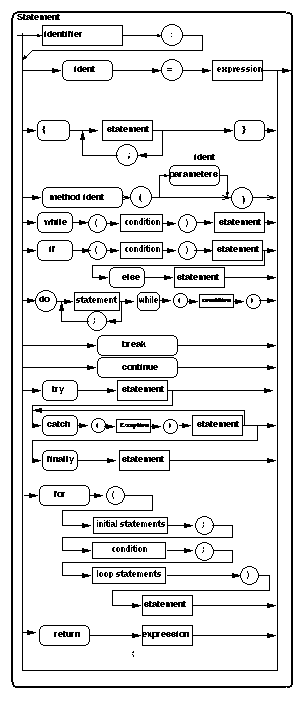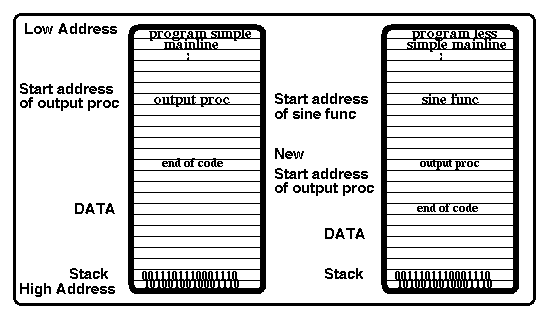 10.2. Predefined Functions and Procedures.
10.2. Predefined Functions and Procedures.  10.2. Predefined Functions and Procedures.
10.2. Predefined Functions and Procedures. 
import local.units.sdsu.io.*;
import java.lang.*;
import java.io.*;
public class Simple
{
public static void main(String argv[]) throws IOException
{
Format.print(System.out,"HELLO WORLD\n");
}
}



STOre the string (or its address) on the stack
CALL print /* print out data */
What address goes in here!?!

Consider:

import local.units.sdsu.io.*;
import java.lang.*;
double y;
public class LessSimple
{
public static void main(String argv[]) throws IOException
{
y = Math.sin(2.0);
Format.print(System.out,"HELLO WORLD\n");
}
}


It is obvious that the start address of 2nd print is going to be different. Therefore how could the compiler know what address to put in to the CALL instruction, so that all the address's for Figure 1 are known?
The compiler doesn't know (nor care) what address to put in
the CALL INSTRUCTION. The compiler generates code (and
information) which directs the LINK or ld program to "Fix-up" the
address's once they become known. Compiler generates a symbolic
address which tells the linker to do the fixup.

Thus when you execute program compiler puts
in symbolic addresses for pre-defined
functions/procedures and the linker program takes
this .o or .REL file.
It is called .REL because it is relocatable
code, i.e. it can be put in more than one
place in memory just as the print code was
moved to fit the sin code in memory.

Look more closely at
/* We may want to store address rather than object if it is very large. */
If all the print procedure gets is a value (or an address) it cannot tell if it is a string or an integer ( 5 characters in a word still is only binary and is an integer. There is nothing special about characters. )
The Java compiler generates information concerning:

(1) Type of the object (integer, real, logical)
(2) Kind of object (array, procedure, function)
(3) Run time address of object = symbolic
(4) Accessing Information: array - dimension - array bounds
procedure - list of parameters and their descriptions.
TABLE 2











